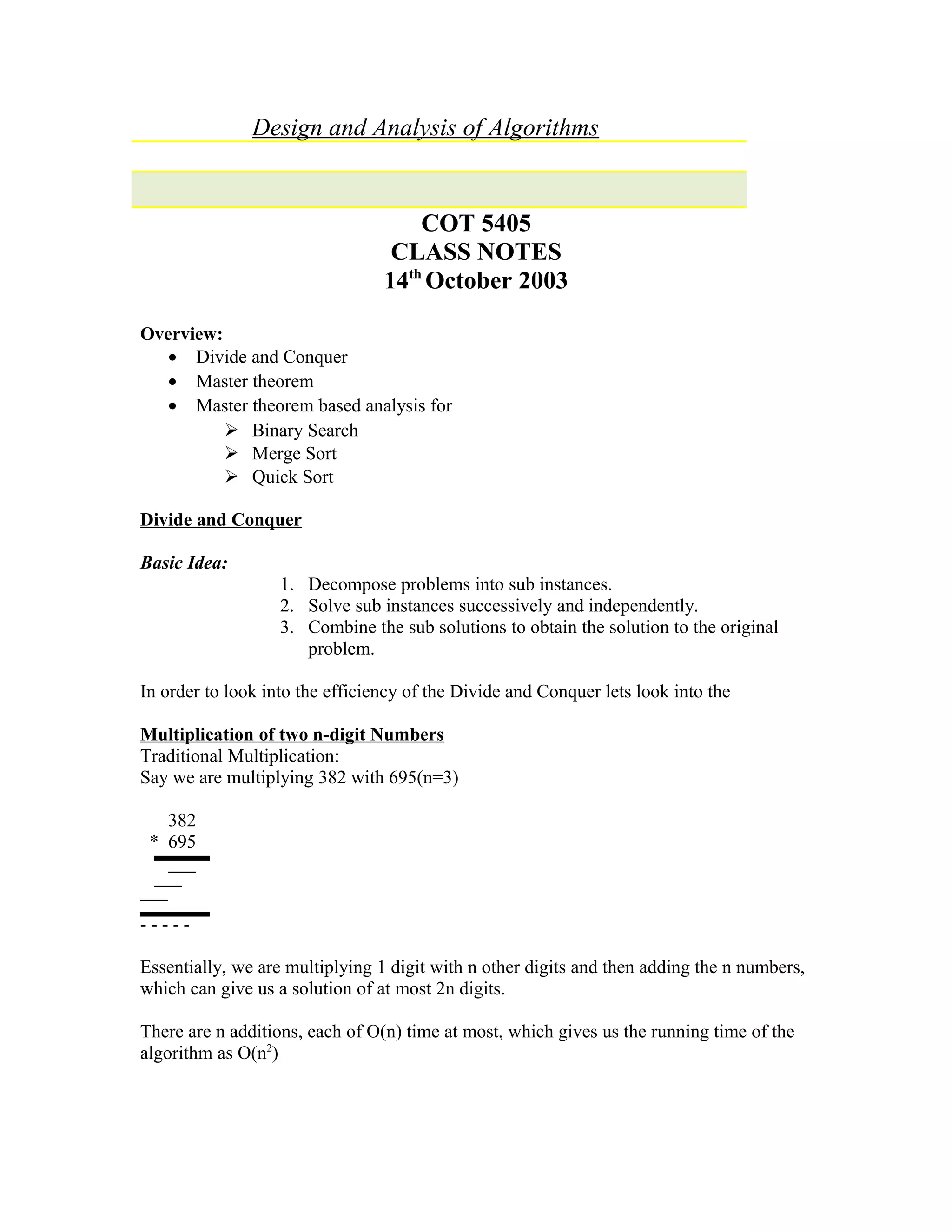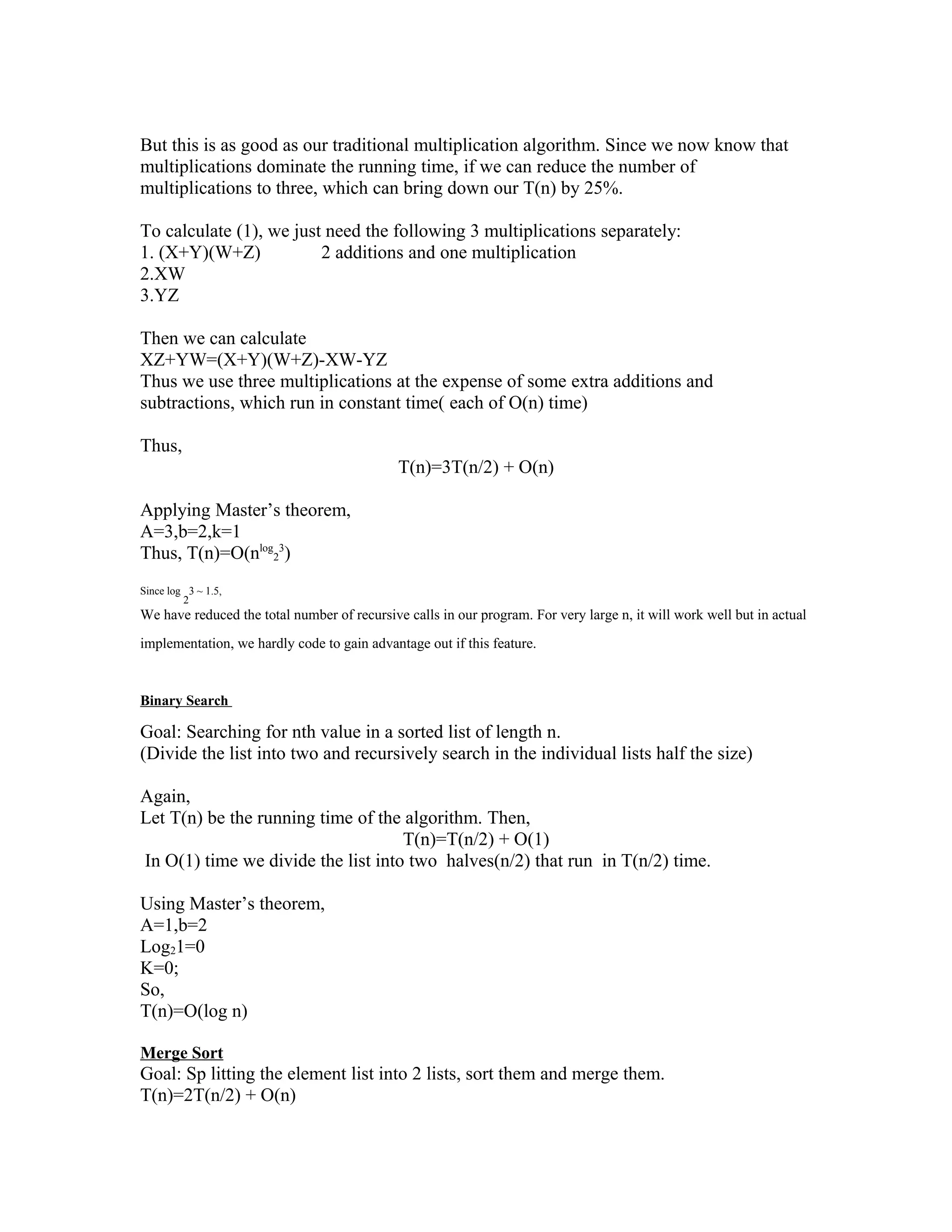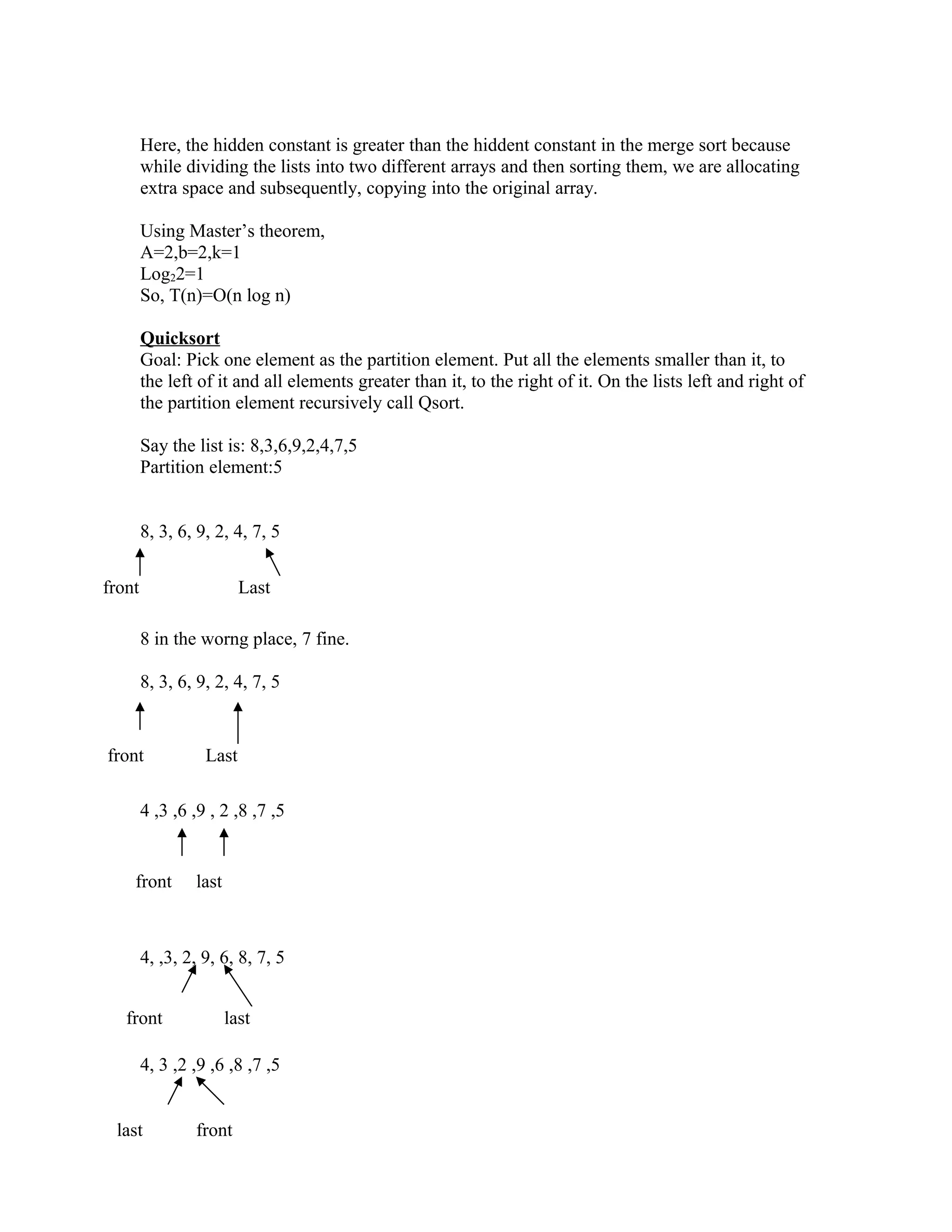(1) The document discusses algorithms analysis using the divide and conquer paradigm and the master theorem. It analyzes the running times of binary search, merge sort, and quicksort using the master theorem.
(2) For quicksort, it shows that picking a random pivot element leads to an expected running time of O(n log n) since it balances the problem sizes on both sides of the pivot in each recursive call.
(3) It ultimately derives that the expected running time of quicksort is O(n log n).

![!!Using Divide and Conquer to multiply n-digit numbers
We will write the two n-digit numbers as follows:
(10n/2
X + Y) (10n/2
W+Z) =10n
XW + (XZ + YW) 10n/2
+YZ ---(1)
That is we are converting the multiplication of two n-digit numbers into multiplication of
four n/2 digit numbers, plus some extra work involved in additions. We are recursively
calling multiplication and performing some additions in every recursion.
Let T (n) be the running time of multiplying two n-digit numbers.
Then in our case,
T (n) = 4T (n/2) +O (n)
• Four multiplications of n/2 digit numbers
• Addition is going to be between numbers that have atmost 2n digits. Thus
addition can be O (n).
Recursively substituting the value of T (n):
T (n) = 4 [4T (n/4) + O (n/2)] +O (n)
=16 T (n/4) + 4O (n/2) + O (n)
-
-
-
=C T (1) + - - - -
Master’s Theorem
Let T(n) be the running time of an algorithm with an input size of n;
Suppose we can run the algorithm in such a way that we make ‘a’ recursive calls every
time with an input size of ‘n/b’ and do some extra work in every recursion (additions and
subtractions).
Such that T (n) can be represented as:
T (n) = a T (n/b) + O (nk
),
Then,
If log ba>k, T (n) =O (nlog
b
a
) (recursive calls dominates)
If log ba=k, T (n) =O (nk
log n) (almost equal work in rec. calls and in extra work)
If log ba<k, T (n) =O (nk
) (Extra work dominates)
In our multiplication problem:
T (n) = 4T (n/2) +O (n)
A=4, b=2
Log24=2, k=1
Since algorithm is dominated by recursive calls and the running time is O (n2
).](https://image.slidesharecdn.com/lecture13divconq-150508060721-lva1-app6892/75/pradeepbishtLecture13-div-conq-2-2048.jpg)


![Now swap front with 5 and we have 5 in place.
4,3,2,5,6,8,7,9
Thus the only extra space utilized here is the temporary variable used for swapping.
In te worst case, we might end up choosing a partition element which is the first element
in our list.
In that case T(n)=O(n2
)
To make sure this rarely happens:
1. Pick a random partition element.
2. Probablity of picking a good partition element is as low as the probability of
picking a bad one. So, they will even out.
There are n possible partition elements
Element Split Prob(element)
1 0,n-1 1/n
2 1,n-2 1/n
3 1/n
N n-1,0 1/n
Now,
T (n) = 1/n [ T(0) + T(n-1) + O(n) ] +
1/n [ T(1) + T(n-2) + O(n) ] +
1/n [ T(2) + T(n-3) + O(n) ] +
……
……
……
1/n [T (n-1) + T (0) + O (n)]
n * T[n] = {2 k=0Σn-1
T(k)} + O(n2
) A
Substitute n = n-1,
(n-1) * T[(n-1)] = {2 k=0Σn-1
T(k)} + O((n-1)2
)B
Subtract A from B](https://image.slidesharecdn.com/lecture13divconq-150508060721-lva1-app6892/75/pradeepbishtLecture13-div-conq-5-2048.jpg)
![n T(n) - (n-1)T(n-1) = 2 T(n-1) + O(n)
n T(n) = n+1 T(n-1) + O(n)
T(n) = ((n+1)/n )T(n-1) + O(1)
Divide by (n+1)
T(n)/(n+1) = [T(n-1) ]/ n + O(1/n) C
Let,
S(n) = T(n)/(n+1) D
S(n) = S(n-1) + O(1/n)
This can be written as a sum,
= S(n-2) + O(1/n-1) + O(1/n)
= S(n-3) + O(1/n-2) + O(1/n-1) + O(1/n)
S(n) = O(k=1 Σ n
1/k)
= O( Hn)
S(n) = T(n)/(n+1) = O (ln n) E
Substitute D in C
T(n) = S(n) . (n+1)
use E,
T(n) = O (ln n) . (n+1)
T(n) = O (n lg n )
Notes compiled by Shankar Vaithianthan and Harjinder Mandarh](https://image.slidesharecdn.com/lecture13divconq-150508060721-lva1-app6892/75/pradeepbishtLecture13-div-conq-6-2048.jpg)
![n T(n) - (n-1)T(n-1) = 2 T(n-1) + O(n)
n T(n) = n+1 T(n-1) + O(n)
T(n) = ((n+1)/n )T(n-1) + O(1)
Divide by (n+1)
T(n)/(n+1) = [T(n-1) ]/ n + O(1/n) C
Let,
S(n) = T(n)/(n+1) D
S(n) = S(n-1) + O(1/n)
This can be written as a sum,
= S(n-2) + O(1/n-1) + O(1/n)
= S(n-3) + O(1/n-2) + O(1/n-1) + O(1/n)
S(n) = O(k=1 Σ n
1/k)
= O( Hn)
S(n) = T(n)/(n+1) = O (ln n) E
Substitute D in C
T(n) = S(n) . (n+1)
use E,
T(n) = O (ln n) . (n+1)
T(n) = O (n lg n )
Notes compiled by Shankar Vaithianthan and Harjinder Mandarh](https://image.slidesharecdn.com/lecture13divconq-150508060721-lva1-app6892/75/pradeepbishtLecture13-div-conq-7-2048.jpg)